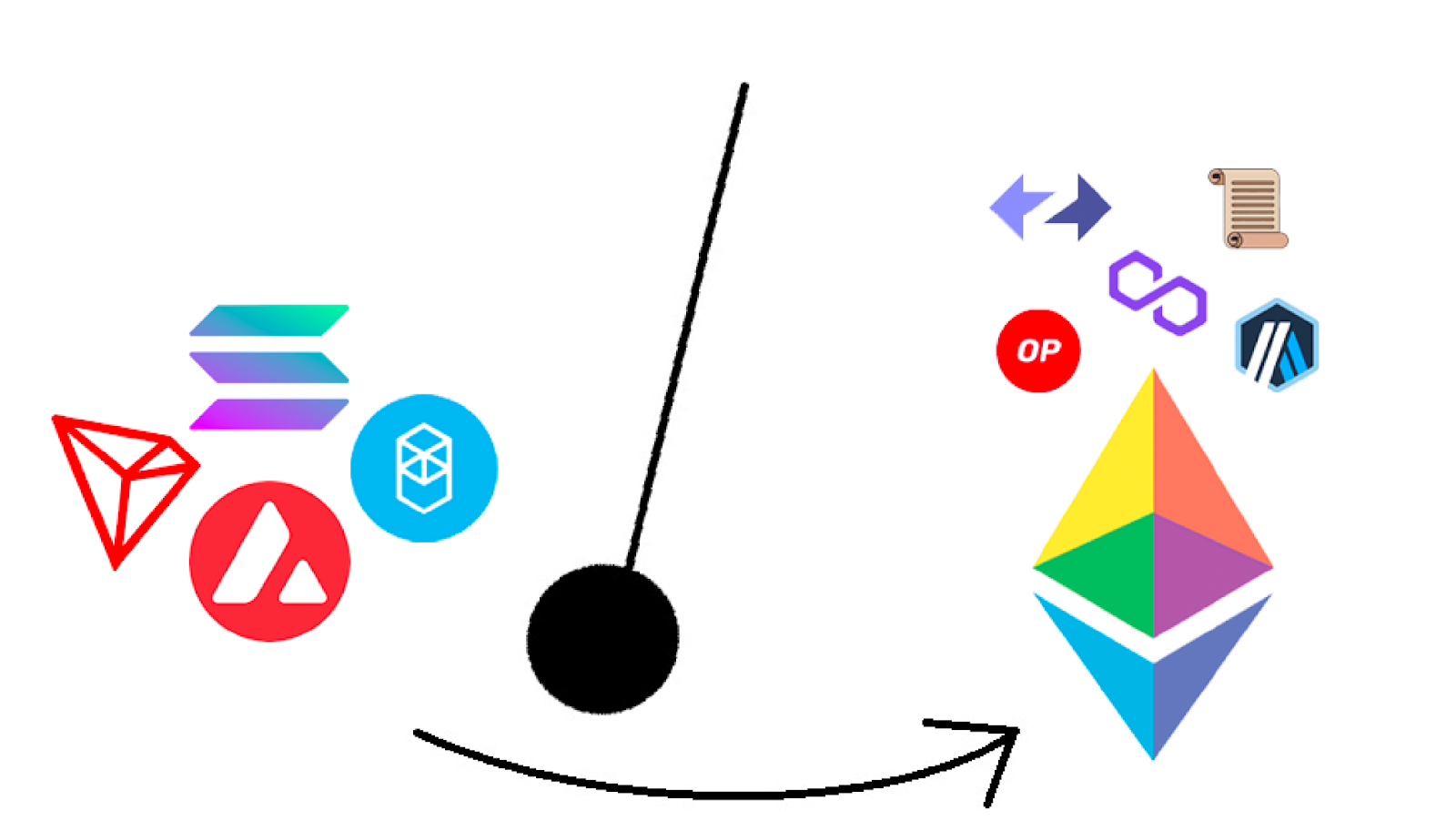EigenLayer: the Harbinger of Restaking

Dear Bankless Nation,
We've spent a lot of time talking about staking over the past few weeks post-Shapella, but now we're finally ready to talk about restaking.
Don't know what restaking is? Today, our very own David Hoffman has some fresh alpha on something you'll likely be hearing a lot more about soon.
- Bankless team
Bankless Writer: David Hoffman
There appears to be a new ‘meta’ on the horizon. Every once in a while on the crypto journey, a frontiersman discovers a new primitive that changes the landscape for the entire industry.
We’ve seen this before with MEV (maximal-extractable-value):
- First, people noticed some high frequency transaction-bots doing this new form of automated arbitrage
- Second, researchers and developers had an ‘oh fuck’ moment about the long-term implications of this kind of activity
- Third, something like FlashBots is created, in order to contain said ‘oh fuck’ moment so that it doesn’t get out of control
- Fourth is where we are now – a new billion-dollar industry has been created, Ethereum has protocol-changing EIPs under development, and MEV as a concept is well-understood by the entire industry
Bankless Nation, I’m here to tell you we’re about to do this all over again.
A new project on the scene, EigenLayer, has produced tons of chatter about the potential of ‘restaking’. While no one knows what the long-term equilibrium of restaking is, there’s good consensus among Ethereum’s deepest thinkers that the staking game will fundamentally change.
Hold onto your butts – the restaking meta is here.
Restaking 101
The best explanation of ‘restaking’ I’ve ever seen has come from Crypto Twitter's beloved Gabriel Haines:
— Gabriel Haines.eth (@gabrielhaines) April 27, 2023
“You take your staked ETH… and you stake it again”
It’s overly reductive, but it’s right. This simple explanation illustrates why ‘restaking’ is so powerful. “You stake it again? What for? Into what? How? Why?”
The answer is yes. Restaking lets you stake your already-staked ETH, for any purpose.
If you’re familiar with the older idea of PoW "Merge Mining”, you can start there as a general concept. Merge mining is where multiple networks can be mined at the same time, using the same “work”. The hashing power from one mining rig is shared between two or more blockchains that have compatible PoW algorithms. One mining rig mining on two blockchains, generating two different sources of revenue.
Applying this to Proof of Stake, restaking is when multiple networks are secured at the same time, using the same capital stake. You stake your ETH to the Beacon Chain, and you’ve given the Beacon Chain the authority to "slash" your ETH if you are malicious to the network. Then, you take your staked ETH and sign up for additional slashing conditions from a different network that you also want to stake for.
For example, you could build an oracle network on top of EigenLayer, where you get your ETH slashed for providing bad data to Ethereum, but also rewarded for providing good data.
Same ETH, different network, new slashing conditions, more rewards.
Impacts and risks on Ethereum security
Restaking has caused concern among some Ethereum protocol devs. Just like with MEV, restaking generates some very significant questions about the long-term health of the Ethereum network. Restaking calls the alignment of ETH stakers into question. Before restaking, ETH stakers only served one network: Ethereum. ETH is staked to Ethereum – and Ethereum alone.
Restaking lets ETH stakers go from Ethereum monogamy to network polyamory. What was once previously a source of committed security to Ethereum now has the option to also commit security to other networks.
Is the health of the Ethereum network at risk if too many ETH stakers become ETH restakers? If ETH stakers are also securing other networks with their ETH, Ethereum security is clearly being diluted as a result. While trying to understand the risks and benefits associated with restaking, I came up with a little comparison to Skyrim mods (or modding in general).
Mods are community-generated changes that enhance or alter a title in some way. The actual game studio provides the ‘base game’ (with years of development costs), and then hobbyists and enthusiasts build off the base game’s network effects with modifications they think are useful and enjoyable.
The biggest Skyrim mods are massive open-source projects that are hardened and robust pieces of code. For example:
- Unofficial Skyrim Patch - Fixes every major bug left by the core Skyrim devs
- New Idles - New animations and movement patterns for players and NPCs
- SkyUI - A huge UI upgrade; inventory management, skill tree navigation, etc.
These mods have been downloaded millions of times, and have undergone their own series of updates, patches, and fixes from open-source contributors. They are good pieces of code, and they’re safe to install on top of the base game.
The problem with mods is that they’re addicting. The “blue chips” of Skyrim are safe, but there’s the insatiable user desire to always test new boundaries. The more esoteric mods you install, the higher the chances there are of something going wrong. Once you're on the 41st page of the mods library and you’ve found yourself installing “My Little Pony Weapons and Armour” along with “Guards Are Chickens” mods, you know you’re in for a hairball of loading contingencies and conflicts.

It’s okay when the costs of mod conflicts are simply crashing the game. The result is a frustrating afternoon. But when we extend this pattern to restaking, it's our ETH and Ethereum’s security that’s at stake.
We call them ‘Degens’ for a reason - it's too easy to imagine restakers staking their ETH into as many protocols as possible, trying to juice their yields to maximize their returns. In crypto, that behavior is table stakes.
Pseudo-enshrinement
Sticking with the mods metaphor, the top mods to titles like Skyrim can often be considered as ‘enshrined mods’ - they provide such a fundamental enhancement to the game that it's kind of crazy to not install them. There’s only upside.
In Ethereum researchland, there’s the concept of ‘enshrined rollups’ or ‘enshrined oracles’, in which a rollup or oracle is built directly into the core Ethereum protocol itself. Consider it 'state-sponsored infrastructure' that benefits from being a first-class citizen compared to others. This can be dangerous too, as it impacts credible neutrality and adds additional risks, which is why you don’t see anything like that in Ethereum currently.
Restaking could create unique situations where large networks garner so much adoption that more than 50% of all staked ETH is restaked to them. In these cases, these networks could effectively become enshrined pieces of Ethereum infrastructure without any EIP to formalize them as such.
Is restaking pseudo-enshrinement an attack-vector for Ethereum?
Should we be worried about this future?
Have networks like Chainlink already created this relationship?
Would a restaked oracle network be more aligned to Ethereum than Chainlink?
There are a lot of open questions here.
Cementing ETH as the internet’s native currency
While it raises a lot of questions, restaking and the idea of an infinitely moddable security layer on the internet is really bullish for ETH.
This is because EigenLayer opens up a near-infinite amount of utility for ETH and ETH staking. Entirely new networks can be birthed on top of ETH as a security layer. Bootstrapping a network is hard, but with EigenLayer, new networks are able to tap into a pre-existing $35B of security by commoditizing ETH staking into generalizable security for new networks.

In crypto, there’s a pendulum between the trends of spawning new L1s and building on pre-existing networks. We watched this play out in Bitcoin in 2017, where some projects chose to fork Bitcoin – ‘airdropping’ new network tokens to BTC holders, versus bootstrapping a new network from scratch (either a new L1, or an ICO on Ethereum).
EigenLayer shifts the incentive-pendulum from the poly-L1 side to a single-shared-network based on ETH. EigenLayer is a downstream conclusion of the idea that capital-begets-capital. ETH and ETH validators are the largest pool of crypto-economic security in the world. In theory, EigenLayer doesn’t care what network it integrates with, but it's incentivized to choose the largest source of economic security in existence - ETH and staked ETH.
EigenLayer lets entirely new kinds of networks be born out of the security of ETH stakers, and the value of these networks ultimately flows down into ETH staking yields, both increasing the incentive to stake ETH and the value of the ETH principle. Each new network is a new bond market of varying degrees of productivity and yield, and each new network is layered upon the highest order form of money in the system: non-restaked ETH.
If the incentives behind EigenLayer and restaking are successful, does ETH become cemented as the internet-native bond? Restaking gives ETH a route to emulate the TradBond world: United States Treasuries as a means of final settlement (only one level higher than hard cash or central bank deposits) and then all other forms of bonds (corporate bonds, municipal bonds, junk bonds etc.) are simply higher-order expressions of base money.
Restaking as network-bootstrapping
EigenLayer democratizes access to bootstrapping a network.
It reduces the barrier to starting a network by commoditizing the economic security provided by ETH into a generally available product. How will this impact the incentives behind network-bootstrapping?
Since the capital costs of security are lowered, does this open up new venues for capital-raising and network distribution? The ‘long tail’ of networks that find it difficult to raise VC money can simply find network security from EigenLayer instead, and ETH stakers who chose to be early network restakers could access the early upside in lieu of VC financing.
Here’s how I see EigenLayer providing an alternative route for network-bootstrapping:
- Some developers decide to spawn a new network using Eigen-security.
- They build a network, launch a mainnet, and open the doors for stakers to restake to their network.
- The network grows from development improvements, restaking security, and ultimately from actual utility and consumption of the network's product (whatever that may be).
- Eventually, it comes time for the network to leave the nest, and “graduate” from Ethereum. The network retroactively issues a token to restakers as thanks for providing early security while the network was young and needed nurturing.
- Now the network has its own native token, and it's in the hands of those who have provided real proven value to the network. First, the network sourced security from ETH restakers, and then it gave those security providers its token, which is the new form of network security. So, the role of airdrop recipients never changes, only the asset that provided security is changed.
Restakers aren’t paying developer salaries or marketing costs so there still may be outside capital needs, but restaking does change the power dynamics as early networks can more easily tap into alternative sources of capital for growing a critical part of their network.
The Restaking Meta
EigenLayer has exposed an entirely new design space for building and bootstrapping crypto-networks. I think we can expect all the same patterns of behaviors we’ve seen countless times in crypto: early experimentation, followed by proofs of concepts, then in-production networks… followed by copycats, fervor, and finally overinvestment.
It’s important to note how early we are in the entire conversation around what restaking is, and how it impacts the long-term equilibrium of the industry. We mostly don’t know what the future of restaking looks like. The questions posed in this piece are only the tip of the iceberg - they’re meant to produce further conversations and inspiration about what potential the restaking meta holds.
But, that’s the fun of the journey, and there’s bound to be opportunity to discover along the way!
Action steps:
- 📺 Watch the Bankless podcast on The State of EigenLayer with Sreeram Kannan